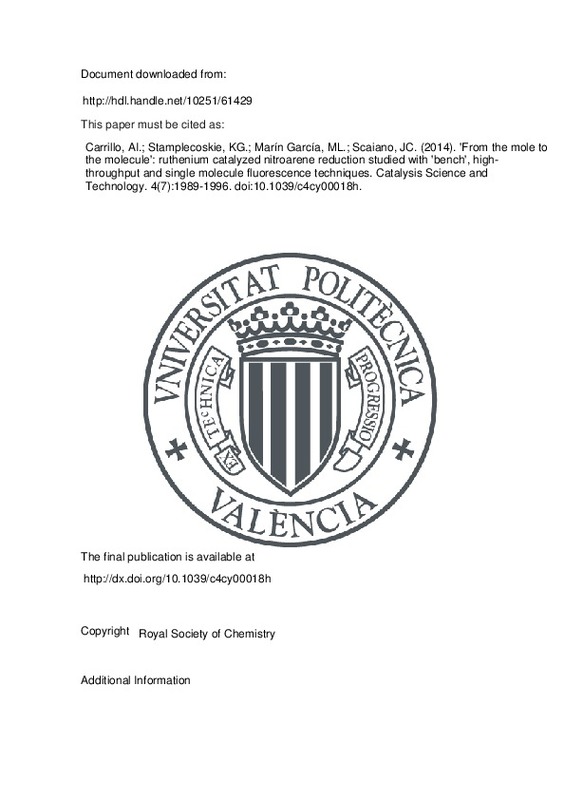Stauffer, S. R., & Hartwig, J. F. (2003). Fluorescence Resonance Energy Transfer (FRET) as a High-Throughput Assay for Coupling Reactions. Arylation of Amines as a Case Study. Journal of the American Chemical Society, 125(23), 6977-6985. doi:10.1021/ja034161p
McNally, A., Prier, C. K., & MacMillan, D. W. C. (2011). Discovery of an -Amino C-H Arylation Reaction Using the Strategy of Accelerated Serendipity. Science, 334(6059), 1114-1117. doi:10.1126/science.1213920
Roeffaers, M. â J., Deâ Cremer, G., Libeert, J., Ameloot, R., Dedecker, P., Bons, A.-J., … Hofkens, J. (2009). Super-Resolution Reactivity Mapping of Nanostructured Catalyst Particles. Angewandte Chemie International Edition, 48(49), 9285-9289. doi:10.1002/anie.200904944
[+]
Stauffer, S. R., & Hartwig, J. F. (2003). Fluorescence Resonance Energy Transfer (FRET) as a High-Throughput Assay for Coupling Reactions. Arylation of Amines as a Case Study. Journal of the American Chemical Society, 125(23), 6977-6985. doi:10.1021/ja034161p
McNally, A., Prier, C. K., & MacMillan, D. W. C. (2011). Discovery of an -Amino C-H Arylation Reaction Using the Strategy of Accelerated Serendipity. Science, 334(6059), 1114-1117. doi:10.1126/science.1213920
Roeffaers, M. â J., Deâ Cremer, G., Libeert, J., Ameloot, R., Dedecker, P., Bons, A.-J., … Hofkens, J. (2009). Super-Resolution Reactivity Mapping of Nanostructured Catalyst Particles. Angewandte Chemie International Edition, 48(49), 9285-9289. doi:10.1002/anie.200904944
Roeffaers, M. B. J., Hofkens, J., De Cremer, G., De Schryver, F. C., Jacobs, P. A., De Vos, D. E., & Sels, B. F. (2007). Fluorescence microscopy: Bridging the phase gap in catalysis. Catalysis Today, 126(1-2), 44-53. doi:10.1016/j.cattod.2007.03.007
Tachikawa, T., & Majima, T. (2012). Single-Molecule, Single-Particle Approaches for Exploring the Structure and Kinetics of Nanocatalysts. Langmuir, 28(24), 8933-8943. doi:10.1021/la300177h
Zhou, X., Xu, W., Liu, G., Panda, D., & Chen, P. (2010). Size-Dependent Catalytic Activity and Dynamics of Gold Nanoparticles at the Single-Molecule Level. Journal of the American Chemical Society, 132(1), 138-146. doi:10.1021/ja904307n
Wee, T.-L. (Erika), Schmidt, L. C., & Scaiano, J. C. (2012). Photooxidation of 9-Anthraldehyde Catalyzed by Gold Nanoparticles: Solution and Single Nanoparticle Studies Using Fluorescence Lifetime Imaging. The Journal of Physical Chemistry C, 116(45), 24373-24379. doi:10.1021/jp308956y
Carrillo, A. I., Schmidt, L. C., Marín, M. L., & Scaiano, J. C. (2014). Mild synthesis of mesoporous silica supported ruthenium nanoparticles as heterogeneous catalysts in oxidative Wittig coupling reactions. Catal. Sci. Technol., 4(2), 435-440. doi:10.1039/c3cy00773a
Del Pozo, C., Corma, A., Iglesias, M., & Sánchez, F. (2011). Recyclable mesoporous silica-supported chiral ruthenium-(NHC)NN-pincer catalysts for asymmetric reactions. Green Chemistry, 13(9), 2471. doi:10.1039/c1gc15412e
HAJEK, J. (2003). Ruthenium-modified MCM-41 mesoporous molecular sieve and Y zeolite catalysts for selective hydrogenation of cinnamaldehyde. Applied Catalysis A: General, 251(2), 385-396. doi:10.1016/s0926-860x(03)00345-4
Prier, C. K., Rankic, D. A., & MacMillan, D. W. C. (2013). Visible Light Photoredox Catalysis with Transition Metal Complexes: Applications in Organic Synthesis. Chemical Reviews, 113(7), 5322-5363. doi:10.1021/cr300503r
Szadkowska, A., Samojłowicz, C., & Grela, K. (2011). Enhancement of ruthenium-catalyzed olefin metathesis reactions: Searching for new catalyst or new reaction conditions? Pure and Applied Chemistry, 83(3), 553-563. doi:10.1351/pac-con-10-09-10
Lara, P., Philippot, K., & Chaudret, B. (2012). Organometallic Ruthenium Nanoparticles: A Comparative Study of the Influence of the Stabilizer on their Characteristics and Reactivity. ChemCatChem, 5(1), 28-45. doi:10.1002/cctc.201200666
R. H. Grubbs , Handbook of Metathesis, Wiley-VCH, Weinheim, 2003
Jansat, S., Picurelli, D., Pelzer, K., Philippot, K., Gómez, M., Muller, G., … Chaudret, B. (2006). Synthesis, characterization and catalytic reactivity of ruthenium nanoparticles stabilized by chiral N-donor ligands. New J. Chem., 30(1), 115-122. doi:10.1039/b509378c
Salas, G., Campbell, P. S., Santini, C. C., Philippot, K., Costa Gomes, M. F., & Pádua, A. A. H. (2012). Ligand effect on the catalytic activity of ruthenium nanoparticles in ionic liquids. Dalton Transactions, 41(45), 13919. doi:10.1039/c2dt31644g
Davies, I. W., Matty, L., Hughes, D. L., & Reider, P. J. (2001). Are Heterogeneous Catalysts Precursors to Homogeneous Catalysts? Journal of the American Chemical Society, 123(41), 10139-10140. doi:10.1021/ja016877v
Montoya, L. A., & Pluth, M. D. (2012). Selective turn-on fluorescent probes for imaging hydrogen sulfide in living cells. Chemical Communications, 48(39), 4767. doi:10.1039/c2cc30730h
Larsen, J. W., Freund, M., Kim, K. Y., Sidovar, M., & Stuart, J. L. (2000). Mechanism of the carbon catalyzed reduction of nitrobenzene by hydrazine. Carbon, 38(5), 655-661. doi:10.1016/s0008-6223(99)00155-4
Al-Soufi, W., Reija, B., Novo, M., Felekyan, S., Kühnemuth, R., & Seidel, C. A. M. (2005). Fluorescence Correlation Spectroscopy, a Tool to Investigate Supramolecular Dynamics: Inclusion Complexes of Pyronines with Cyclodextrin. Journal of the American Chemical Society, 127(24), 8775-8784. doi:10.1021/ja0508976
Witham, C. A., Huang, W., Tsung, C.-K., Kuhn, J. N., Somorjai, G. A., & Toste, F. D. (2009). Converting homogeneous to heterogeneous in electrophilic catalysis using monodisperse metal nanoparticles. Nature Chemistry, 2(1), 36-41. doi:10.1038/nchem.468
Nishina, Y., Miyata, J., Kawai, R., & Gotoh, K. (2012). Recyclable Pd–graphene catalyst: mechanistic insights into heterogeneous and homogeneous catalysis. RSC Advances, 2(25), 9380. doi:10.1039/c2ra21185h
Nørskov, J. K., Bligaard, T., Rossmeisl, J., & Christensen, C. H. (2009). Towards the computational design of solid catalysts. Nature Chemistry, 1(1), 37-46. doi:10.1038/nchem.121
[-]







![[Cerrado]](/themes/UPV/images/candado.png)


